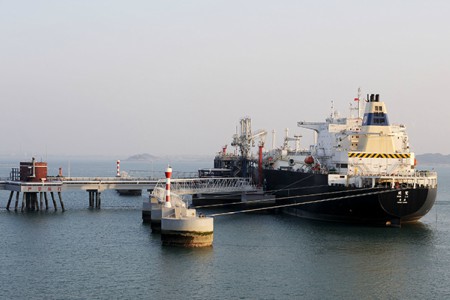China's CNOOC spends big on floating LNG emergency stash
BEIJING (Reuters) — China's state-owned CNOOC is spending $10 MM to lease two tankers to store an emergency stash of LNG amid growing concerns that China is facing a winter fuel crisis, a source with direct knowledge of the matter said.
 |
LNG tankers are not only among the most expensive merchant vessels to hire, but keeping the fuel super-chilled is energy intensive and costly, much more expensive than putting crude on an oil tanker for later sale.
Also, market conditions mean the value of the LNG stores are likely to have fallen from their purchase price by the time CNOOC starts selling off the supplies.
The move highlights the unusual methods being employed by the state major to plug shortages as China's campaign to convert millions of homes to gas heating from coal and force factories to use gas boilers for the first time boosts demand.
"It's like buying insurance to cover winter demand spikes," said the trading source with knowledge of the deal.
CNOOC, China's largest importer of LNG, last year hired one tanker for a similar purpose, said the source.
"CNOOC arranged (to lease the two tankers) months ago anticipating the shortage will be severe this year ... so this is the first time two tankers are hired," he said.
CNOOC leased Cool Explorer [C}KL7309529502] and Neo Energy [C}KL7309489798] under a short-term arrangement roughly costing $10 MM, or $40,000 a day, during China's heating season between mid-November and mid-March, said the trading source.
Details of the arrangement came after the company announced on Tuesday it had leased the tankers. CNOOC did not immediately respond to an email for comment.
China's surge in natural gas demand has exposed inadequate infrastructure and insufficient domestic output much earlier than most experts expected, with domestic LNG prices soaring over the past month to record highs this week.
Just two weeks into the start of the heating season, two major consuming provinces warned last week of shortages and cut supplies to some users.
Beijing Gas, a local government-controlled distributor in the Chinese capital, had a similar operation last winter to cover demand spikes in case of a cold snap, according to gas analysts at consultancies Wood Mackenzie and SIA Energy.
FALLING LNG VALUES
For any product, storage makes economic sense only if future prices are higher than those for immediate delivery, a market condition called contango.
The Asian spot LNG curve, however, is in backwardation, meaning future prices are lower than prompt market levels.
Asian spot LNG prices for January delivery are at almost $10/MMBtu. By April, they are expected to be barely above $7/MMBtu.
The CNOOC-leased vessels store gas at minus 160°C, and each has a capacity of about 150,000 cubic meters.
Neo Energy was last seen on Reuters shipping tracking system in Japanese waters heading to South Korea, having previously docked at Shimizu.
Cool Explorer was anchored on Wednesday off Hainan in southern China, the shipping data showed.
CNOOC will typically park the tankers between its receiving terminals in Tianjin in the north and Ningbo on the east coast, and will move the ships around and pick up new supplies once they are emptied, said the trading source.
CNOOC operates a floating storage and regasification unit (FSRU), Cape Ann, as the anchor supplier to Tianjin, where imported LNG is offloaded and transferred to trailers that then delivered the fuel to industrial and residential users.
The floating storage is partly needed because CNOOC's regasification capacity is small at Tianjin compared to that of domestic rival PetroChina's nearby Caofeidian LNG terminal.
Reporting by Chen Aizhu in BEIJING; Additional reporting by Henning Gloystein and Keith Wallis in Singapore; Editing by Josephine Mason

- ExxonMobil halts 1-Bft3d blue hydrogen project in Texas
- Aramco and Yokogawa commission multiple autonomous control AI agents at Fadhili gas plant
- Ukraine will resume gas imports via Transbalkan route in November
- Mitsubishi to inject $260 MM into Brunei LNG project
- Freeport LNG (U.S.) on track to take in more natgas on Thursday after unit outage



Comments